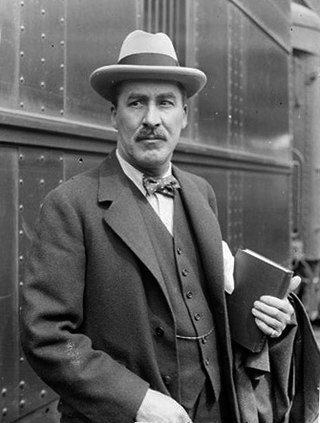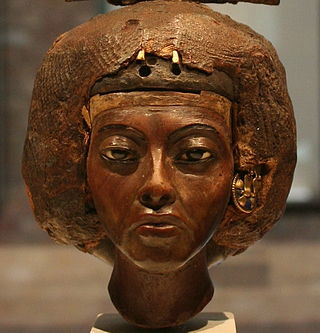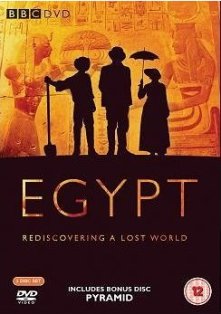Related Research Articles

Howard Carter was a British archaeologist and Egyptologist who discovered the intact tomb of the 18th Dynasty Pharaoh Tutankhamun in November 1922, the best-preserved pharaonic tomb ever found in the Valley of the Kings.

Tutankhamun was the antepenultimate pharaoh of the Eighteenth Dynasty of ancient Egypt. He ascended to the throne around the age of nine and reigned until his death around the age of nineteen. The most significant actions of his reign were reversing the societal changes enacted by his predecessor, Akhenaten, during the Amarna Period: Tutankhamun restored the traditional polytheistic form of ancient Egyptian religion, undoing the religious shift known as Atenism, and moved the royal court away from Akhenaten's capital, Amarna. Tutankhamun was one of few kings worshipped as a deity during his lifetime; this was usually done posthumously for most pharaohs. In popular culture, he is known for his vastly opulent wealth found during the 1922 discovery of his tomb, KV62, the only such tomb to date to have been found in near-intact condition. The discovery of his tomb is widely considered one of the greatest archaeological discoveries of all time.

Akhenaten, also spelled Akhenaton or Echnaton, was an ancient Egyptian pharaoh reigning c. 1353–1336 or 1351–1334 BC, the tenth ruler of the Eighteenth Dynasty. Before the fifth year of his reign, he was known as Amenhotep IV.

Neferneferuaten Nefertiti was a queen of the 18th Dynasty of Ancient Egypt, the great royal wife of Pharaoh Akhenaten. Nefertiti and her husband were known for their radical overhaul of state religious policy, in which they promoted the earliest known form of monotheism, Atenism, centered around the sun disc and its direct connection to the royal household. With her husband, she reigned at what was arguably the wealthiest period of ancient Egyptian history. Some scholars believe that Nefertiti ruled briefly as Neferneferuaten after her husband's death and before the ascension of Tutankhamun, although this identification is a matter of ongoing debate. If Nefertiti did rule as Pharaoh, her reign was marked by the fall of Amarna and relocation of the capital back to the traditional city of Thebes.

Tiye was the Great Royal Wife of the Egyptian pharaoh Amenhotep III, mother of pharaoh Akhenaten and grandmother of pharaoh Tutankhamun; her parents were Yuya and Thuya. In 2010, DNA analysis confirmed her as the mummy known as "The Elder Lady" found in the tomb of Amenhotep II (KV35) in 1898.

Kiya was one of the wives of the Egyptian Pharaoh Akhenaten. Little is known about her, and her actions and roles are poorly documented in the historical record, in contrast to those of Akhenaten's ‘Great royal wife’, Nefertiti. Her unusual name suggests that she may originally have been a Mitanni princess. Surviving evidence demonstrates that Kiya was an important figure at Akhenaten's court during the middle years of his reign, when she had a daughter with him. She disappears from history a few years before her royal husband's death. In previous years, she was thought to be mother of Tutankhamun, but recent DNA evidence suggests this is unlikely.
Lynda Suzanne Robinson is an American writer, author of romance and mystery novels. She is best known for her series of historical whodunnits set in Ancient Egypt during the reign of Tutankhamun and featuring Lord Meren, "the Eyes and Ears of Pharaoh". She lives in Texas with her husband and has a doctorate in anthropology from the University of Texas at Austin.

Winifred Mabel Bruntonnée Newberry was a South African painter, illustrator and Egyptologist.

Egypt is a BBC television docudrama serial portraying events in the history of Egyptology from the 18th through early 20th centuries. It originally aired on Sunday nights at 9 pm on BBC1 in 2005. The first two episodes explored the work of Howard Carter and his archaeological quest in Egypt in the early part of the twentieth century. The next two episodes focused on the eccentric explorer "The Great Belzoni" played here by Matthew Kelly. The final two episodes dramatise the discovery and deciphering of the Rosetta Stone by Jean-François Champollion.
Joann Fletcher is an Egyptologist and an honorary visiting professor in the department of archaeology at the University of York. She has published a number of books and academic articles, including several on Cleopatra, and made numerous television and radio appearances. In 2003, she controversially claimed to have identified the mummy of Queen Nefertiti.

Joyce Ann Tyldesley is a British archaeologist and Egyptologist, academic, writer and broadcaster who specialises in the women of ancient Egypt.

Harry Burton was an English archaeological photographer, best known for his photographs of excavations in Egypt's Valley of the Kings. Today, he is sometimes referred to as an Egyptologist, since he worked for the Egyptian Expedition of the Metropolitan Museum of Art for around 25 years, from 1915 until his death. His most famous photographs are the estimated 3,400 or more images that he took documenting Howard Carter's excavation of Tutankhamun's tomb from 1922 to 1932.

The question of the race of ancient Egyptians was raised historically as a product of the early racial concepts of the 18th and 19th centuries, and was linked to models of racial hierarchy primarily based on craniometry and anthropometry. A variety of views circulated about the racial identity of the Egyptians and the source of their culture. Some scholars argued that ancient Egyptian culture was influenced by other Afroasiatic-speaking populations in North Africa, the Horn of Africa or the Middle East, while others pointed to influences from various Nubian groups or populations in Europe. In more recent times some writers continued to challenge the mainstream view, some focusing on questioning the race of specific notable individuals such as the king represented in the Great Sphinx of Giza, native Egyptian pharaoh Tutankhamun, Egyptian Queen Tiye, and Greek Ptolemaic queen Cleopatra VII.
Percy Edward Newberry was a British Egyptologist.
Thomas Garnet Henry James,, known as Harry James, was a British Egyptologist, epigrapher, and museum curator. He is best known for his career long association with the British Museum, serving with the Department of Ancient Egypt from 1951 to 1988, including 14 years as Keeper. He also had a large number of outside scholarly interests and wrote a large number of important research works on the subject of Ancient Egypt.

Arthur Cruttenden Mace was a Tasmanian-born English archaeologist and Egyptologist. He is best known for his work for the New York Metropolitan Museum, and as a part of Howard Carter's team during the excavation of Tutankhamun's tomb.
Colleen Darnell is an American Egyptologist. Her areas of expertise include Late Period uses of the Underworld Books, ancient Egyptian military history, the literature of New Kingdom Egypt, and Egyptian revival history.

The mask of Tutankhamun is a gold funerary mask of the 18th-dynasty ancient Egyptian pharaoh Tutankhamun. After being buried for over 3,000 years, it was excavated by Howard Carter in 1925 from tomb KV62 in the Valley of the Kings and is now in the Egyptian Museum in Cairo. The death mask is one of the best-known works of art in the world and a prominent symbol of ancient Egypt.
Fayza Mohamed Hussein Haikal is a professor emerita of Egyptology at the American University in Cairo and the first Egyptian woman to earn a PhD in Egyptology.

The tomb of Tutankhamun was discovered in the Valley of the Kings in 1922 by excavators led by the Egyptologist Howard Carter. Whereas the tombs of most pharaohs were plundered by graverobbers in ancient times, Tutankhamun's tomb was hidden by debris for most of its existence and therefore not extensively robbed. It thus became the first known largely intact royal burial from ancient Egypt. To date, the discovery of Tutankhamun's tomb is widely considered one of the most famous archaeological discoveries of all time.
References
- ↑ "Elizabeth Frood". The Oriental Institute. University of Oxford. Retrieved 25 July 2020.
- ↑ "Dr Elizabeth Frood". St Cross College. University of Oxford. Retrieved 25 July 2020.
- ↑ Seager, Charlotte (25 February 2017). "'My boss called me a hypochondriac' – your stories of working with disabilities". The Guardian. Retrieved 25 July 2020.
- ↑ Wynyard, Jane (12 November 2016). "My cousin's brave battle with sepsis: 'You went to the pub, I returned legless'". Stuff. Retrieved 25 July 2020.
- ↑ Pickles, Matt (9 September 2016). "Egyptologist returns to work after recovery from sepsis". Oxford Arts Blog. University of Oxford. Retrieved 25 July 2020.
- ↑ Frood, Elizabeth (15 October 2018). "Returning to Egypt: acquired disability and fieldwork". Oxford Arts Blog. University of Oxford. Retrieved 25 July 2020.
- ↑ "'I'm Indiana Jones - with prosthetics'". BBC News. 15 October 2018. Retrieved 25 July 2020.
- ↑ Bradshaw, Paul (18 June 2020). "Bringing Tutankhamun to life in colour. Behind the Scenes". Broadcast Now. Retrieved 14 June 2021.
- ↑ "Tutankhamun in Colour". BBC Media Centre.
- ↑ Krasteva, Gergana (30 October 2020). "Oxford Egyptologist fronts fashion campaign for Kintsugi". Oxford Mail. Retrieved 14 June 2021.
- ↑ "Journal of Ancient History".